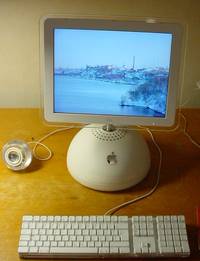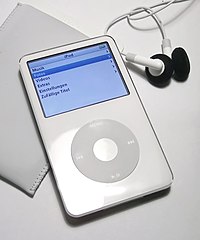Career at Apple Computer
Since Steve Jobs returned to Apple Computer in 1997, Ive has headed the industrial design team that produces most of the company's current hardware products. Ive's team designed the original iMac and its successors, the original iBook and its successors, the Power Mac starting with the Power Macintosh G3 (Blue & White), the Power Mac G4 Cube, the PowerBook starting with the Titanium PowerBook G4 (or possibly earlier), the eMac, the Mac mini, the Xserve and Xserve RAID as well as the iPod family, the AirPort base station family, and the Apple Cinema Display and some later Studio Displays. The team has also assisted in the design of some third-party Mac accessories such as the Harman Kardon Soundsticks speaker system.

Phases
There have been distinct phases in Ive's designs for Apple. The first style appeared in 1998 with the release of the original iMac and was also evident in the clamshell iBook models, as well as the Blue and White Power Mac G3 and its accompanying line of Studio Displays. This design is characterized by translucent candy-coloured and milky white surfaces with soft, bulging shapes. Subdued vertical pinstripes show through the translucent faces of these Macs and displays. Printed on the back panel for ports and agency approval marks is a lenticular plaque that contains a wavy 3D pattern. Even the power cords are translucent, showing the twist of wires within.
The translucency and colours in this style were inspired by gumdrop candies. In fact, Ive visited confectionery companies for advice on replicating a gumdrop's visual effect, and his team developed novel techniques in order to build it. The candy colour on the first iMac model is called "Bondi blue", evoking the colour of the sea at beaches such as Sydney's Bondi Beach.
The "Bondi blue" iMac was replaced with five fruit colours in January 1999, "Blueberry" (a bright blue); "Grape" (purple); "Tangerine" (orange); "Lime" (green); and "Strawberry" (pinkish red). Two of these, "Tangerine" and "Blueberry", became the first colours for the iBook. Blueberry was also the color for the Blue and White Power Mac G3 and its displays. These candy colors started a fad in consumer goods where everything from clock radios to hamburger grillers had translucent bright plastic.

In late 1999, the fruit colours were joined by a quieter colour scheme called "Graphite", in which the coloured elements were replaced with a smokey grey and some of the white elements were made transparent. Graphite was the colour of the iMac Special Edition models and the first Power Mac G4. Next came "Ruby" (dark red), "Sage" (forest green), "Indigo" (deep blue) and "Snow" (milky white) in 2000. The iBooks' colors were also updated: Blueberry was replaced with Indigo, Tangerine was replaced with Key Lime (an eye-popping neon green), and Graphite was added at the high end.
In 2001, two new color schemes were introduced: "Flower Power" and "Blue Dalmatian". "Flower Power" was white with flowers, and "Blue Dalmatian" was a blue similar to the original "Bondi blue", but with white spots. The "Snow" color scheme was also used on the second generation iBook.
Only the PowerBook G3 was uninfluenced by the translucent style (with the exception of a translucent bronze-colored keyboard on the Lombard and Pismo models), retaining its opaque black casing until it was replaced by the Titanium PowerBook G4 in 2001.
Ive's more recent product designs for Apple have shifted away from multicolored translucency and been split down the middle, with the consumer products moving toward a glossy white coloring and opaque finishes and the professional products gaining industrial brushed aluminium. The former soft, bulging shapes have been replaced by more streamlined, orthogonal, minimalist shapes.
It seems that the success and wide embrace of Apple's iPod has had a lasting effect on Ive and his design team. Some have noted the striking similarity of the iPod's design with the subsequent iMac G5 and Mac mini designs. Apple even promoted the release of the iMac G5 as coming "from the creators of iPod", and in the accompanying promotional photographs the products were shown next to each other in profile, highlighting the similarities in their design.
